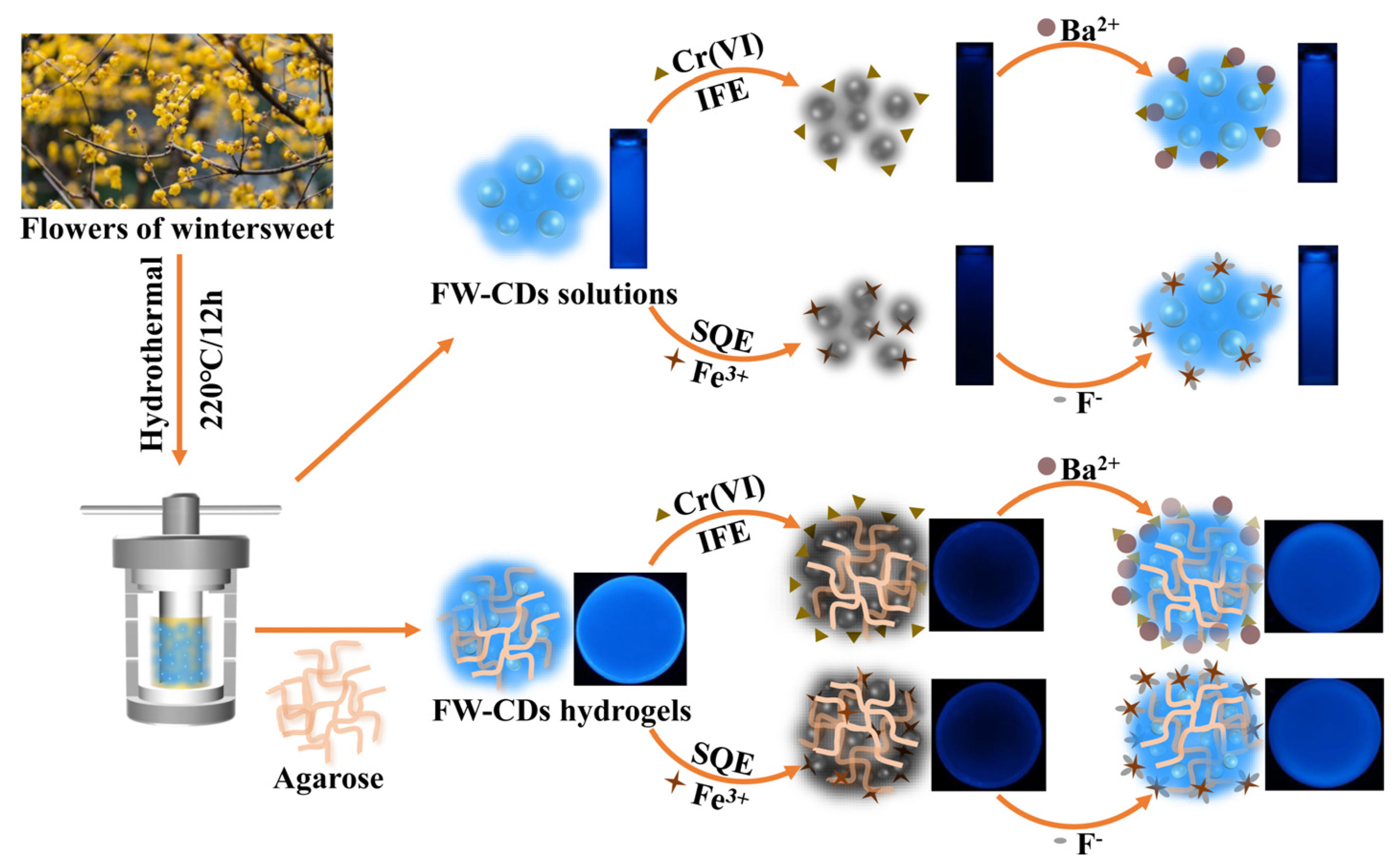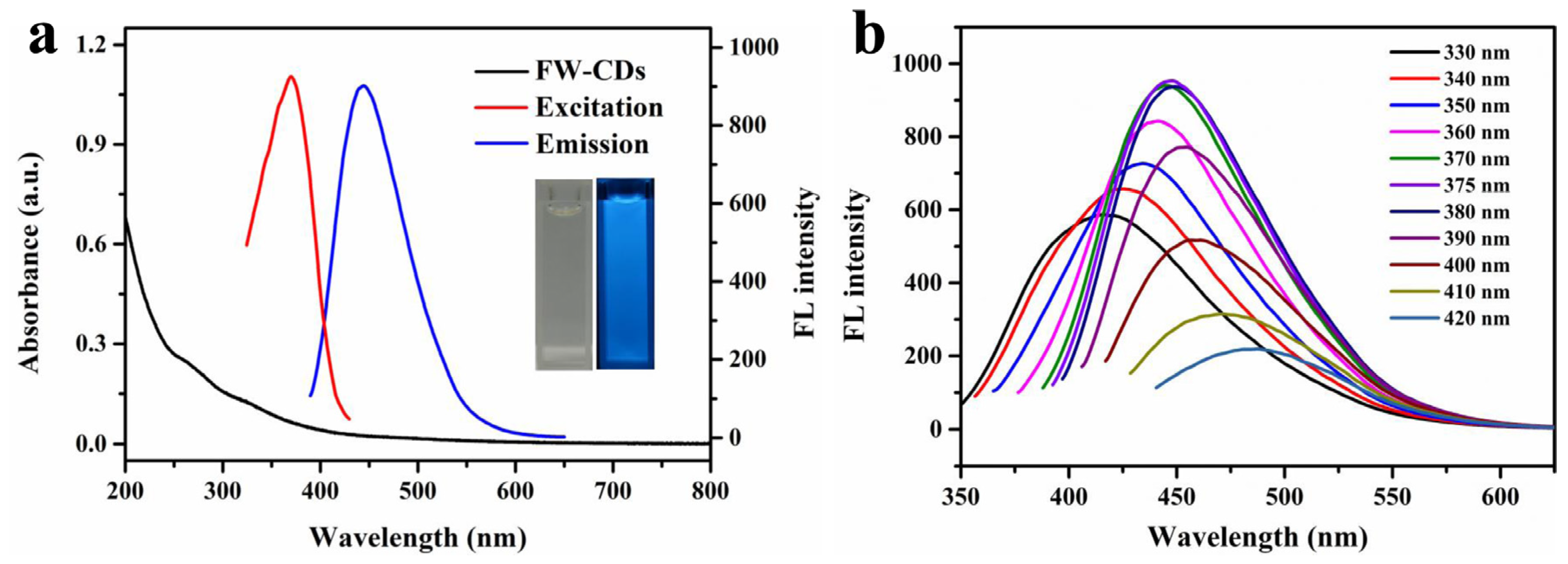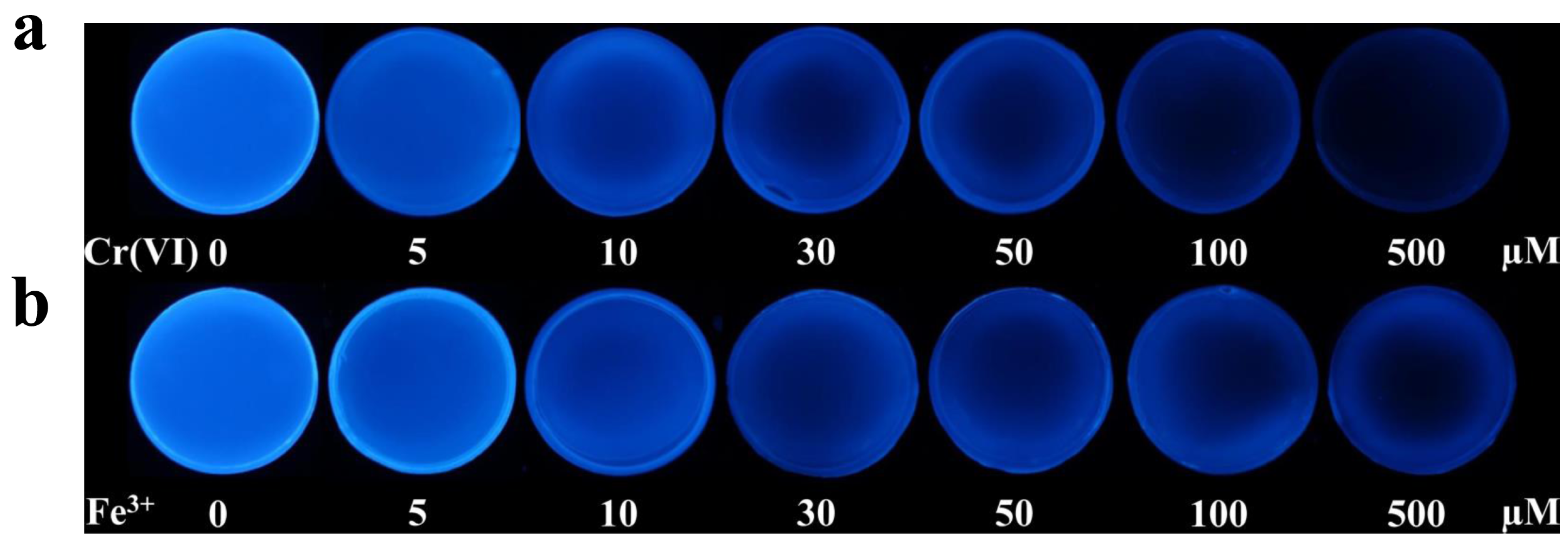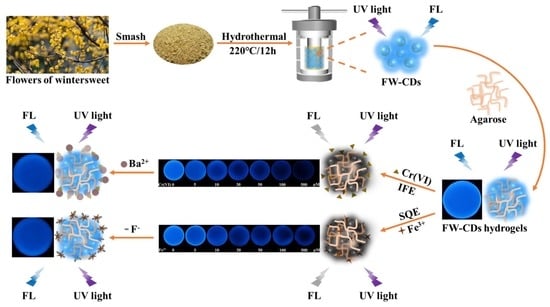Sustainable and Green Synthesis of Waste-Biomass-Derived Carbon Dots for Parallel and Semi-Quantitative Visual Detection of Cr(VI) and Fe3+
Abstract
:1. Introduction
2. Materials and Methods
2.1. Materials
2.2. Characterization
2.3. Synthesis and Purification of Fluorescent FW-CDs
2.4. Fluorescence Detection of Cr(VI) and Fe3+
2.5. Assays of Cr(VI) and Fe3+ in Real Samples
2.6. Preparation of FW-CD-Based Fluorescent Hydrogel Sensor
3. Results and Discussion
3.1. Characterization of FW-CDs
3.2. Optical Properties and Photostability of FW-CDs
3.3. Fluorescence Analysis of FW-CDs to Cr(VI) and Fe3+
3.4. Possible Quenching Mechanism of Cr(VI) and Fe3+ to FW-CDs
3.5. Quantitative and Parallel Determination of Cr(VI) and Fe3+ in Environmental Water Samples
3.6. Quantitative Determination of Cr(VI) in Industrial Effluent
3.7. Quantitative Determination of Fe2+ in Oral Iron Supplement
3.8. On-Site Semi-Quantitative Visual Determination of Cr(VI) and Fe3+ in Real Samples
4. Conclusions
Supplementary Materials
Author Contributions
Funding
Data Availability Statement
Acknowledgments
Conflicts of Interest
Sample Availability
References
- Han, M.; Zhu, S.; Lu, S.; Song, Y.; Feng, T.; Tao, S.; Liu, J.; Yang, B. Recent progress on the photocatalysis of carbon dots: Classification, mechanism and applications. Nano Today 2018, 19, 201–218. [Google Scholar] [CrossRef]
- Zhang, X.; Liu, C.; Li, Z.; Guo, J.; Shen, L.; Guo, W.; Zhang, L.; Ruan, S.; Long, Y. An easily prepared carbon quantum dots and employment for inverted organic photovoltaic devices. Chem. Eng. J. 2017, 315, 621–629. [Google Scholar] [CrossRef]
- Qiu, Y.; Gao, D.; Yin, H.; Zhang, K.; Zeng, J.; Wang, L.; Xia, L.; Zhou, K.; Xia, Z.; Fu, Q. Facile, green and energy-efficient preparation of fluorescent carbon dots from processed traditional Chinese medicine and their applications for on-site semi-quantitative visual detection of Cr(VI). Sens. Actuators B Chem. 2020, 324, 128722. [Google Scholar] [CrossRef]
- Zhang, Y.; Zhou, K.; Qiu, Y.; Xia, L.; Xia, Z.; Zhang, K.; Fu, Q. Strongly emissive formamide-derived N-doped carbon dots embedded Eu(III)-based metal-organic frameworks as a ratiometric fluorescent probe for ultrasensitive and visual quantitative detection of Ag+. Sens. Actuators B Chem. 2021, 339, 129922. [Google Scholar] [CrossRef]
- Huang, H.; Xu, Y.; Tang, C.-J.; Chen, J.-R.; Wang, A.-J.; Feng, J.-J. Facile and green synthesis of photoluminescent carbon nanoparticles for cellular imaging. New J. Chem. 2013, 38, 784–789. [Google Scholar] [CrossRef]
- Wei, X.; Li, L.; Liu, J.; Yu, L.; Li, H.; Cheng, F.; Yi, X.; He, J.; Li, B. Green Synthesis of Fluorescent Carbon Dots from Gynostemma for Bioimaging and Antioxidant in Zebrafish. ACS Appl. Mater. Interfaces 2019, 11, 9832–9840. [Google Scholar] [CrossRef]
- Yao, Y.-Y.; Gedda, G.; Girma, W.M.; Yen, C.-L.; Ling, Y.-C.; Chang, J.-Y. Magnetofluorescent Carbon Dots Derived from Crab Shell for Targeted Dual-Modality Bioimaging and Drug Delivery. ACS Appl. Mater. Interfaces 2017, 9, 13887–13899. [Google Scholar] [CrossRef]
- Liu, H.; Sun, Y.; Yang, J.; Hu, Y.; Yang, R.; Li, Z.; Qu, L.; Lin, Y. High performance fluorescence biosensing of cysteine in human serum with superior specificity based on carbon dots and cobalt-derived recognition. Sens. Actuators B Chem. 2018, 280, 62–68. [Google Scholar] [CrossRef]
- Chaudhary, S.; Umar, A.; Bhasin, K.K.; Singh, S. Applications of Carbon Dots in Nanomedicine. J. Biomed. Nanotechnol. 2017, 13, 591–637. [Google Scholar] [CrossRef]
- Hou, Y.; Lu, Q.; Deng, J.; Li, H.; Zhang, Y. One-pot electrochemical synthesis of functionalized fluorescent carbon dots and their selective sensing for mercury ion. Anal. Chim. Acta 2015, 866, 69–74. [Google Scholar] [CrossRef]
- Myint, A.A.; Rhim, W.-K.; Nam, J.-M.; Kim, J.; Lee, Y.-W. Water-soluble, lignin-derived carbon dots with high fluorescent emissions and their applications in bioimaging. J. Ind. Eng. Chem. 2018, 66, 387–395. [Google Scholar] [CrossRef]
- Liu, Y.; Zhou, Q.; Yuan, Y.; Wu, Y. Hydrothermal synthesis of fluorescent carbon dots from sodium citrate and polyacrylamide and their highly selective detection of lead and pyrophosphate. Carbon 2017, 115, 550–560. [Google Scholar] [CrossRef]
- Li, J.-Y.; Liu, Y.; Shu, Q.-W.; Liang, J.-M.; Zhang, F.; Chen, X.-P.; Deng, X.-Y.; Swihart, M.T.; Tan, K.-J. One-pot hydrothermal synthesis of carbon dots with efficient up-and down-converted photoluminescence for the sensi-tive detection of morin in a dual-readout assay. Langmuir 2017, 33, 1043–1050. [Google Scholar] [CrossRef] [PubMed]
- Zhao, D.; Liu, X.; Wei, C.; Qu, Y.; Xiao, X.; Cheng, H. One-step synthesis of red-emitting carbon dots via a solvothermal method and its application in the detection of methylene blue. RSC Adv. 2019, 9, 29533–29540. [Google Scholar] [CrossRef] [Green Version]
- De Medeiros, T.V.; Manioudakis, J.; Noun, F.; Macairan, J.-R.; Victoria, F.; Naccache, R. Microwave-assisted synthesis of carbon dots and their applications. J. Mater. Chem. C 2019, 7, 7175–7195. [Google Scholar] [CrossRef]
- Liu, H.; Ding, J.; Zhang, K.; Ding, L. Construction of biomass carbon dots based fluorescence sensors and their applications in chemical and biological analysis. TrAC Trends Anal. Chem. 2019, 118, 315–337. [Google Scholar] [CrossRef]
- Liu, Y.; Zhu, C.; Gao, Y.; Yang, L.; Xu, J.; Zhang, X.; Lu, C.; Wang, Y.; Zhu, Y. Biomass-derived nitrogen self-doped carbon dots via a simple one-pot method: Physicochemical, structural, and luminescence properties. Appl. Surf. Sci. 2020, 510, 145437. [Google Scholar] [CrossRef]
- Jayaweera, S.; Yin, K.; Ng, W.J. Nitrogen-Doped Durian Shell Derived Carbon Dots for Inner Filter Effect Mediated Sensing of Tetracycline and Fluorescent Ink. J. Fluoresc. 2018, 29, 221–229. [Google Scholar] [CrossRef] [PubMed]
- Guo, J.; Li, H.; Ling, L.; Li, G.; Cheng, R.; Lu, X.; Xie, A.-Q.; Li, Q.; Wang, C.-F.; Chen, S. Green Synthesis of Carbon Dots toward Anti-Counterfeiting. ACS Sustain. Chem. Eng. 2019, 8, 1566–1572. [Google Scholar] [CrossRef]
- Wang, H.; Zhang, M.; Ma, Y.; Wang, B.; Shao, M.; Huang, H.; Liu, Y.; Kang, Z. Selective inactivation of Gram-negative bacteria by carbon dots derived from natural biomass: Artemisia argyi leaves. J. Mater. Chem. B 2020, 8, 2666–2672. [Google Scholar] [CrossRef]
- Liu, Z.; Jin, W.; Wang, F.; Li, T.; Nie, J.; Xiao, W.; Zhang, Q.; Zhang, Y. Ratiometric fluorescent sensing of Pb2+ and Hg2+ with two types of carbon dot nanohybrids synthesized from the same biomass. Sens. Actuators B Chem. 2019, 296, 126698. [Google Scholar] [CrossRef]
- Rao, H.; Liu, W.; He, K.; Zhao, S.; Lu, Z.; Zhang, S.; Sun, M.; Zou, P.; Wang, X.; Zhao, Q.; et al. Smartphone-Based Fluorescence Detection of Al3+ and H2O Based on the Use of Dual-Emission Biomass Carbon Dots. ACS Sustain. Chem. Eng. 2020, 8, 8857–8867. [Google Scholar] [CrossRef]
- Atchudan, R.; Edison, T.N.J.I.; Perumal, S.; Muthuchamy, N.; Lee, Y.R. Hydrophilic nitrogen-doped carbon dots from biowaste using dwarf banana peel for environmental and biological applications. Fuel 2020, 275, 117821. [Google Scholar] [CrossRef]
- Huang, H.; Lv, J.J.; Zhou, D.L.; Bao, N.; Xu, Y.; Wang, A.J.; Feng, J.J. One-pot green synthesis of nitrogen-doped carbon na-noparticles as fluorescent probes for mercury ions. RSC Adv. 2013, 3, 21691–21696. [Google Scholar] [CrossRef]
- Li, L.-S.; Jiao, X.-Y.; Zhang, Y.; Cheng, C.; Huang, K.; Xu, L.J. Highly fluorescent carbon dots synthesized with binary dopants for “turn off” and “turn off-on” sensing and cell imaging. Sens. Actuators B Chem. 2018, 268, 84–92. [Google Scholar] [CrossRef]
- Barati, A.; Shamsipur, M.; Abdollahi, H. Metal-ion-mediated fluorescent carbon dots for indirect detection of sulfide ions. Sens. Actuators B Chem. 2016, 230, 289–297. [Google Scholar] [CrossRef]
- Feng, Y.; Zhong, D.; Miao, H.; Yang, X. Carbon dots derived from rose flowers for tetracycline sensing. Talanta 2015, 140, 128–133. [Google Scholar] [CrossRef]
- Dang, D.K.; Sundaram, C.; Ngo, Y.-L.T.; Choi, W.M.; Chung, J.S.; Kim, E.J.; Hur, S.H. Pyromellitic acid-derived highly fluo-rescent N-doped carbon dots for the sensitive and selective determination of 4-nitrophenol. Dye Pigments 2019, 165, 327–334. [Google Scholar] [CrossRef]
- Yu, J.; Song, N.; Zhang, Y.-K.; Zhong, S.-X.; Wang, A.-J.; Chen, J. Green preparation of carbon dots by Jinhua bergamot for sensitive and selective fluorescent detection of Hg2+ and Fe3+. Sens. Actuators B Chem. 2015, 214, 29–35. [Google Scholar] [CrossRef]
- Long, R.; Tang, C.; Li, T.; Tong, X.; Tong, C.; Guo, Y.; Gao, Q.; Wu, L.; Shi, S. Dual-emissive carbon dots for dual-channel ratiometric fluorometric determination of pH and mercury ion and intracellular imaging. Mikrochim. Acta 2020, 187, 307. [Google Scholar] [CrossRef]
- Wang, Y.; Chang, Q.; Hu, S. Carbon dots with concentration-tunable multicolored photoluminescence for simultaneous de-tection of Fe3+ and Cu2+ ions. Sens. Actuators B Chem. 2017, 253, 928–933. [Google Scholar] [CrossRef]
- Gao, Y.; Jiao, Y.; Lu, W.; Liu, Y.; Han, H.; Gong, X.; Xian, M.; Shuang, S.; Dong, C. Carbon dots with red emission as a fluo-rescent and colorimeteric dual-readout probe for the detection of chromium (vi) and cysteine and its logic gate operation. J. Mater. Chem. B 2018, 6, 6099–6107. [Google Scholar] [CrossRef] [PubMed]
- Lv, X.; Man, H.; Dong, L.; Huang, J.; Wang, X. Preparation of highly crystalline Nitrogen-doped carbon dots and their ap-plication in sequential fluorescent detection of Fe3+ and ascorbic acid. Food Chem. 2020, 326, 126935. [Google Scholar] [CrossRef]
- Li, L.; Shi, L.; Jia, J.; Jiao, Y.; Gao, Y.; Liu, Y.; Dong, C.; Shuang, S. “On-off-on” detection of Fe3+ and F−, biological imaging, and its logic gate operation based on excitation-independent blue-fluorescent carbon dots. Spectrochim. Acta Part A Mol. Biomol. Spectrosc. 2019, 227, 117716. [Google Scholar] [CrossRef] [PubMed]
- Wang, W.-X.; Cao, L.; Xiong, J.; Xia, G.; Hu, J.-F. Constituents from Chimonanthus praecox (wintersweet). Phytochem. Lett. 2011, 4, 271–274. [Google Scholar] [CrossRef]
- Lv, J.-S.; Zhang, L.-L.; Chu, X.-Z.; Zhou, J.-F. Chemical composition, antioxidant and antimicrobial activity of the extracts of the flowers of the Chinese plant Chimonanthus praecox. Nat. Prod. Res. 2012, 26, 1363–1367. [Google Scholar] [CrossRef]
- Spanu, D.; Binda, G.; Dossi, C.; Monticelli, D. Biochar as an alternative sustainable platform for sensing applications: A review. Microchem. J. 2020, 159, 105506. [Google Scholar] [CrossRef]
- Meng, W.; Bai, X.; Wang, B.; Liu, Z.; Lu, S.; Yang, B. Biomass-Derived Carbon Dots and Their Applications. Energy Environ. Mater. 2019, 2, 172–192. [Google Scholar] [CrossRef]
- Lou, Y.; Hao, X.; Liao, L.; Zhang, K.; Chen, S.; Li, Z.; Ou, J.; Qin, A.; Li, Z. Recent advances of biomass carbon dots on syntheses, characterization, luminescence mechanism, and sensing applications. Nano Sel. 2021, 2, 1117–1145. [Google Scholar] [CrossRef]
- Xiao, M.; Liu, Z.; Xu, N.; Jiang, L.; Yang, M.; Yi, C. A Smartphone-Based Sensing System for On-Site Quantitation of Multiple Heavy Metal Ions Using Fluorescent Carbon Nanodots-Based Microarrays. ACS Sensors 2020, 5, 870–878. [Google Scholar] [CrossRef]
- Jin, W.; Du, H.; Zheng, S.; Zhang, Y. Electrochemical processes for the environmental remediation of toxic Cr(VI): A review. Electrochim. Acta 2016, 191, 1044–1055. [Google Scholar] [CrossRef]
- Zhang, Y.; Gao, Z.; Yang, X.; Chang, J.; Liu, Z.; Jiang, K. Fish-scale-derived carbon dots as efficient fluorescent nanoprobes for detection of ferric ions. RSC Adv. 2019, 9, 940–949. [Google Scholar] [CrossRef] [Green Version]
- Chen, K.; Qing, W.; Hu, W.; Lu, M.; Wang, Y.; Liu, X. On-off-on fluorescent carbon dots from waste tea: Their properties, antioxidant and selective detection of CrO42−, Fe3+, ascorbic acid and L-cysteine in real samples. Spectrochim. Acta Part A Mol. Biomol. Spectrosc. 2019, 213, 228–234. [Google Scholar] [CrossRef]
- Bardhan, S.; Roy, S.; Chanda, D.K.; Ghosh, S.; Mondal, D.; Das, S.; Das, S. Nitrogenous carbon dot decorated natural micro-cline: An ameliorative dual fluorometric probe for Fe3+ and Cr6+ detection. Dalton Trans. 2020, 49, 10554–10566. [Google Scholar] [CrossRef] [PubMed]
- Li, C.; Liu, W.; Sun, X.; Pan, W.; Wang, J. Multi sensing functions integrated into one carbon-dot based platform via different types of mechanisms. Sens. Actuators B Chem. 2017, 252, 544–553. [Google Scholar] [CrossRef]
- Sahu, S.; Behera, B.; Maiti, T.K.; Mohapatra, S. Simple one-step synthesis of highly luminescent carbon dots from orange juice: Application as excellent bio-imaging agents. Chem. Commun. 2012, 48, 8835–8837. [Google Scholar] [CrossRef]
- Diao, H.; Li, T.; Zhang, R.; Kang, Y.; Liu, W.; Cui, Y.; Wei, S.; Wang, N.; Li, L.; Wang, H.; et al. Facile and green synthesis of fluorescent carbon dots with tunable emission for sensors and cells imaging. Spectrochim. Acta Part A Mol. Biomol. Spectrosc. 2018, 200, 226–234. [Google Scholar] [CrossRef]
- Wu, Y.; Wang, X. Preparation and characterization of single-phase α-Fe2O3 nano-powders by Pechini sol-gel method. Mater. Lett. 2011, 65, 2062–2065. [Google Scholar] [CrossRef]
- Abdelghany, A.; Menazea, A.; Ismail, A.M. Synthesis, characterization and antimicrobial activity of Chitosan/Polyvinyl Al-cohol blend doped with Hibiscus sabdariffa L. extract. J. Mol. Struct. 2019, 1197, 603–609. [Google Scholar] [CrossRef]
- Li, J.; Li, S.; Liu, Q.; Yin, C.; Tong, L.; Chen, C.; Zhang, J. Synthesis of Hydrogen-Substituted Graphyne Film for Lithium-Sulfur Battery Applications. Small 2019, 15, e1805344. [Google Scholar] [CrossRef]
- Elsheikha, H.M.; Elsaied, N.A.; Chan, K.L.A.; Brignell, C.; Harun, M.S.R.; Wehbe, K.; Cinquee, G. Label-free characterization of biochemical changes within human cells under parasite attack using synchrotron based micro-FTIR. Anal. Methods 2019, 11, 2518–2530. [Google Scholar] [CrossRef]
- Tong, M.; He, L.; Rong, H.; Li, M.; Kim, H. Transport behaviors of plastic particles in saturated quartz sand without and with biochar/Fe3O4-biochar amendment. Water Res. 2019, 169, 115284. [Google Scholar] [CrossRef]
- Dang, F.; Zhao, W.; Yang, P.; Wu, H.; Liu, Y. Nitrogen and sulfur co-doped hierarchical graphene hydrogel for high-performance electrode materials. J. Appl. Electrochem. 2020, 50, 463–473. [Google Scholar] [CrossRef]
- Yao, C.; Xu, J.; Zhu, Y.; Zhang, R.; Shen, Y.; Xie, A. Porous CoP@N/P co-doped carbon/CNTs nanocubes: In-situ autocatalytic synthesis and excellent performance as the anode for lithium-ion batteries. Appl. Surf. Sci. 2020, 513, 145777. [Google Scholar] [CrossRef]
- Ibukun, O.; Jeong, H.K. Enhancement of photocatalytic activities of nitrogen-doped titanium dioxide by ambient plasma. Chem. Phys. Lett. 2020, 744, 137234. [Google Scholar] [CrossRef]
- Moon, I.K.; Ki, B.; Oh, J. Three-dimensional porous stretchable supercapacitor with wavy structured PEDOT:PSS/graphene electrode. Chem. Eng. J. 2019, 392, 123794. [Google Scholar] [CrossRef]
- Wu, X.; Wang, R.; Li, W.; Feng, B.; Hu, W. Rh2P Nanoparticles Partially Embedded in N/P-Doped Carbon Scaffold at Ultralow Metal Loading for High Current Density Water Electrolysis. ACS Appl. Nano Mater. 2021, 4, 3369–3376. [Google Scholar] [CrossRef]
- Pacquiao, M.R.; de Luna, M.D.G.; Thongsai, N.; Kladsomboon, S.; Paoprasert, P. Highly fluorescent carbon dots from enokitake mushroom as multi-faceted optical nanomaterials for Cr6+ and VOC detection and imaging applications. Appl. Surf. Sci. 2018, 453, 192–203. [Google Scholar] [CrossRef]
- Zheng, X.; Qin, K.; He, L.; Ding, Y.; Luo, Q.; Zhang, C.; Cui, X.; Tan, Y.; Li, L.; Wei, Y. Novel fluorescent nitrogen-doped carbon dots derived from Panax notoginseng for bioimaging and high selectivity detection of Cr6+. Analyst 2020, 146, 911–919. [Google Scholar] [CrossRef]
- Atchudan, R.; Edison, T.N.J.I.; Chakradhar, D.; Perumal, S.; Shim, J.-J.; Lee, Y.R. Facile green synthesis of nitrogen-doped carbon dots using Chionanthus retusus fruit extract and investigation of their suitability for metal ion sensing and biological applications. Sens. Actuators B Chem. 2017, 246, 497–509. [Google Scholar] [CrossRef]
- Bogireddy, N.K.R.; Rios, S.E.S.; Agarwal, V. Simple one step synthesis of dual-emissive heteroatom doped carbon dots for acetone sensing in commercial products and Cr(VI) reduction. Chem. Eng. J. 2021, 414, 128830. [Google Scholar] [CrossRef]
- Liu, S.; Cui, J.; Huang, J.; Tian, B.; Jia, F.; Wang, Z. Facile one-pot synthesis of highly fluorescent nitrogen-doped carbon dots by mild hydrothermal method and their applications in detection of Cr(VI) ions. Spectrochim. Acta Part A Mol. Biomol. Spectrosc. 2018, 206, 65–71. [Google Scholar] [CrossRef] [PubMed]
- Shen, J.; Shang, S.; Chen, X.; Wang, D.; Cai, Y. Highly fluorescent N, S-co-doped carbon dots and their potential applications as antioxidants and sensitive probes for Cr (VI) detection. Sens. Actuators B Chem. 2017, 248, 92–100. [Google Scholar] [CrossRef]
- Wang, H.; Liu, S.; Xie, Y.; Bi, J.; Li, Y.; Song, Y.; Cheng, S.; Li, D.; Tan, M. Facile one-step synthesis of highly luminescent N-doped carbon dots as an efficient fluorescent probe for chromium(vi) detection based on the inner filter effect. New J. Chem. 2018, 42, 3729–3735. [Google Scholar] [CrossRef]
- Zheng, X.; Ren, S.; Wang, L.; Gai, Q.; Dong, Q.; Liu, W. Controllable functionalization of carbon dots as fluorescent sensors for independent Cr(Ⅵ), Fe(Ⅲ) and Cu(Ⅱ) ions detection. J. Photochem. Photobiol. A Chem. 2021, 417, 113359. [Google Scholar] [CrossRef]
- Shen, J.; Shang, S.; Chen, X.; Wang, D.; Cai, Y. Facile synthesis of fluorescence carbon dots from sweet potato for Fe3+ sensing and cell imaging. Mater. Sci. Eng. C 2017, 76, 856–864. [Google Scholar] [CrossRef]
- Senol, A.M.; Bozkurt, E. Facile green and one-pot synthesis of seville orange derived carbon dots as a fluorescent sensor for Fe3+ ions. Microchem. J. 2020, 159, 105357. [Google Scholar] [CrossRef]
- Yin, H.; Zhang, K.; Wang, L.; Zhou, K.; Zeng, J.; Gao, D.; Xia, Z.; Fu, Q. Redox modulation of polydopamine surface chemistry: A facile strategy to enhance the intrinsic fluorescence of polydopamine nanoparticles for sensitive and selective detection of Fe3+. Nanoscale 2018, 10, 18064–18073. [Google Scholar] [CrossRef]








| Samples | Precursors of CDs | Linear Range (µM) | LOD (µM) | Ref. |
|---|---|---|---|---|
| Cr(VI)/Fe3+ | Waste tea | 1.9–115.4/53.5–267.9 | 0.81/0.15 | [43] |
| Natural microcline | 0–68/0–68 | 4/19 | [44] | |
| Citric acid/acrylamide | 8–160/1–40, 2–180 | 2.10/0.87 | [45] | |
| DECDs | 10–100/10–100 | 3.2/4.1 | [61] | |
| Flowers of wintersweet | 0.1–60/0.05–100 | 0.07/0.15 | This work |
| Samples | Precursors of CDs | Linear Range (µM) | LOD (µM) | Ref. |
|---|---|---|---|---|
| Cr(VI) | Enokitake mushroom | 10–50 | 0.73 | [58] |
| Citric acid/ethylenediamine | 0–10 | 0.26 | [62] | |
| Pomelo | 1–40 | 0.52 | [63] | |
| Citric acid and glycine | 5–200 | 4.16 | [64] | |
| af-CDs | 0.8–80 | 0.24 | [65] | |
| Flowers of wintersweet | 0.1–60 | 0.07 | This work | |
| Fe3+ | pf-CDs | 0.8–80 | 0.16 | [65] |
| Sweet potato | 1–100 | 0.32 | [66] | |
| Seville orange | 33–133 | 0.53 | [67] | |
| Dwarf banana peel | 5–25 | 0.66 | [23] | |
| Fish scales | 1–78 | 0.54 | [42] | |
| Flowers of wintersweet | 0.05–100 | 0.15 | This work |
| Cr(VI) (μM) | Aex | Aem | CF | Fobsd | Fcor | Eobsd | Ecor | Fcor/Fcor,0 |
|---|---|---|---|---|---|---|---|---|
| 0 | 0.031 | 0.015 | 1.050 | 905.48 | 950.67 | 0 | 0 | 1 |
| 10 | 0.055 | 0.021 | 1.086 | 869.19 | 943.63 | 0.040 | 0.003 | 0.992 |
| 20 | 0.075 | 0.025 | 1.115 | 835.93 | 931.97 | 0.077 | 0.020 | 0.980 |
| 30 | 0.094 | 0.030 | 1.145 | 792.54 | 907.18 | 0.125 | 0.046 | 0.954 |
| 50 | 0.143 | 0.038 | 1.218 | 710.34 | 865.22 | 0.216 | 0.090 | 0.910 |
| Sample | Added (µM) | Found (µM) | Found (µM) (ICP-OES) | Recovery (%) | Recovery (%) (ICP-OES) |
|---|---|---|---|---|---|
| Tap | 0 | ND * | ND | - | - |
| 5 | 5.81 ± 1.1 * | 4.96 ± 2.6 | 116.2 ± 1.1 | 99.2 ± 2.6 | |
| 10 | 9.45 ± 0.3 | 10.06 ± 1.7 | 94.5 ± 0.3 | 100.6 ± 1.7 | |
| 20 | 20.07 ± 0.3 | 19.98 ± 0.4 | 100.4 ± 0.3 | 99.9 ± 0.4 | |
| Lake | 0 | ND | ND | - | - |
| 5 | 4.63 ± 1.8 | 5.02 ± 2.9 | 92.6 ± 1.8 | 100.4 ± 2.9 | |
| 10 | 10.24 ± 0.3 | 9.76 ± 1.1 | 102.4 ± 0.3 | 97.6 ± 1.1 | |
| 20 | 19.97 ± 0.6 | 19.32 ± 0.9 | 99.9 ± 0.6 | 96.6 ± 0.9 | |
| River | 0 | ND | ND | - | - |
| 5 | 5.12 ± 1.6 | 4.50 ± 1.1 | 102.4 ± 1.6 | 90.0 ± 1.1 | |
| 10 | 10.11 ± 0.7 | 9.68 ± 1.1 | 101.1 ± 0.7 | 96.8 ± 1.1 | |
| 20 | 19.91 ± 0.5 | 19.12 ± 0.9 | 99.6 ± 0.5 | 95.6 ± 0.9 |
| Sample | Added (µM) | Found (µM) | Found (µM) (ICP-OES) | Recovery (%) | Recovery (%) (ICP-OES) |
|---|---|---|---|---|---|
| Tap | 0 | 0.15 ± 8.0 * | 0.10 ± 6.0 | - | - |
| 5 | 5.12 ± 1.2 | 5.20 ± 1.9 | 99.4 ± 1.2 | 102.0 ± 1.9 | |
| 10 | 10.12 ± 5.7 | 10.66 ± 3.2 | 99.7 ± 5.7 | 105.6 ± 3.2 | |
| 20 | 19.91 ± 1.4 | 20.43 ± 0.6 | 98.8 ± 1.4 | 101.7 ± 0.6 | |
| Lake | 0 | 0.18 ± 2.1 | 0.06 ± 8.4 | - | - |
| 5 | 4.42 ± 6.0 | 4.41 ± 4.7 | 84.8 ± 6.0 | 87.0 ± 4.7 | |
| 10 | 10.30 ± 2.8 | 10.34 ± 1.9 | 101.2 ± 2.8 | 102.8 ± 1.9 | |
| 20 | 19.91 ± 1.6 | 20.28 ± 2.5 | 98.7 ± 1.6 | 101.1 ± 2.5 | |
| River | 0 | 0.08 ± 2.6 | 0.03 ± 3.9 | - | - |
| 5 | 5.32 ± 1.2 | 4.92 ± 1.1 | 104.8 ± 1.2 | 97.8 ± 1.1 | |
| 10 | 9.68 ± 3.0 | 9.85 ± 5.2 | 96.0 ± 3.0 | 98.2 ± 5.2 | |
| 20 | 20.08 ± 0.9 | 19.70 ± 1.0 | 100.0 ± 0.9 | 98.4 ± 1.0 |
Publisher’s Note: MDPI stays neutral with regard to jurisdictional claims in published maps and institutional affiliations. |
© 2022 by the authors. Licensee MDPI, Basel, Switzerland. This article is an open access article distributed under the terms and conditions of the Creative Commons Attribution (CC BY) license (https://creativecommons.org/licenses/by/4.0/).
Share and Cite
Xia, L.; Li, X.; Zhang, Y.; Zhou, K.; Yuan, L.; Shi, R.; Zhang, K.; Fu, Q. Sustainable and Green Synthesis of Waste-Biomass-Derived Carbon Dots for Parallel and Semi-Quantitative Visual Detection of Cr(VI) and Fe3+. Molecules 2022, 27, 1258. https://doi.org/10.3390/molecules27041258
Xia L, Li X, Zhang Y, Zhou K, Yuan L, Shi R, Zhang K, Fu Q. Sustainable and Green Synthesis of Waste-Biomass-Derived Carbon Dots for Parallel and Semi-Quantitative Visual Detection of Cr(VI) and Fe3+. Molecules. 2022; 27(4):1258. https://doi.org/10.3390/molecules27041258
Chicago/Turabian StyleXia, Lan, Xiuju Li, Yuanhua Zhang, Kai Zhou, Long Yuan, Rui Shi, Kailian Zhang, and Qifeng Fu. 2022. "Sustainable and Green Synthesis of Waste-Biomass-Derived Carbon Dots for Parallel and Semi-Quantitative Visual Detection of Cr(VI) and Fe3+" Molecules 27, no. 4: 1258. https://doi.org/10.3390/molecules27041258
APA StyleXia, L., Li, X., Zhang, Y., Zhou, K., Yuan, L., Shi, R., Zhang, K., & Fu, Q. (2022). Sustainable and Green Synthesis of Waste-Biomass-Derived Carbon Dots for Parallel and Semi-Quantitative Visual Detection of Cr(VI) and Fe3+. Molecules, 27(4), 1258. https://doi.org/10.3390/molecules27041258






